Abstract
Ceratozamia schiblii (Zamiaceae), a new species endemic to the highlands of eastern Oaxaca, Mexico, is described. The new species is part of the C. robusta species complex, which is a group of closely related species with very similar morphology. Among them, the new species can be distinguished by its brown leaflets in emerging leaves, a very long peduncle in seed cones, and the green color of mature pollen cones. Compared with the other species in the C. robusta species complex, C. schiblii has one of the longest rachides, and the highest number of leaflet pairs. The recognition of C. schiblii apparently resolves the total number of species within the C. robusta species complex. The region where C. schiblii populations occur coincides with the Neogene refugia areas of the Neotropical flora, which adds evidence to the importance of the mountain systems from Oaxaca and Chiapas, Mexico, in the diversification history of cycads.
1. Introduction
In recent years, knowledge about the systematics of Mexican cycads has advanced due to the increasing usage of morphological, anatomical, and genetic data to evaluate novel, as well as previously known, discoveries. This multidisciplinary approach has resulted in a significant increase in the number of newly described species across the three cycad genera native to Mexico: Dioon Lindl., Zamia L., and Ceratozamia Brongn. Indeed, some 26 cycad species in Mexico have been described in the last 20 years. Most Mexican species are endemic to the southern states of Oaxaca, Chiapas, and Veracruz, a region recognized as one of the main hotspots of cycad diversity in the New World [1,2,3]. The majority of cycad species are considered threatened [4], so an increased understanding of the species richness and diversity within this region will contribute to their conservation.
Ceratozamia (Zamiaceae) is a Neotropical cycad genus with 36 recognized species, 33 of which occur exclusively in Mexico [5]. The genus is associated with tropical montane cloud forests, oak forests, and evergreen tropical forests, spanning a wide range of elevations from near sea level to approximately 1950 m above sea level (m a.s.l.) [6]. All species are defined according to qualitative and quantitative morphological variation of leaves, leaflets, and reproductive structures [2,6]. Generally, there is a correspondence between geographic isolation and species’ range delimitation; and it is generally expected that isolated populations occurring in distinct mountain ranges are likely to show qualitative variation, which is an indicator that they might belong to separate species. However, the taxonomic delimitation of species based solely on diagnostic morphological characters is not always possible. Some species closely resemble each other morphologically, and in many cases, populations previously thought to belong to a single species were subsequently separated into two or more taxa when statistical approaches to test quantitative diagnostic trait differentiation are applied [2,6,7].
Ceratozamia species can be classified into different “species complexes” [2,7]. A species complex refers to a group of species that share morphological features and are expected to be phylogenetically closely related. This morphological similarity among members of a species complex often makes it difficult to distinguish one species from the others within the group. One of the largest complexes in the genus is the “C. robusta species complex” [2], which has a wide distribution through Chiapas, Tabasco, Veracruz, Guerrero, and Oaxaca in Mexico, extending to Belize and Guatemala (Figure 1). The species in this complex are distinguished from other species in the genus by having larger trunks, leaves, and cones. The habitats for the species in the complex are usually associated with karstic forests and can be found in a wide range of elevations and associated vegetation [6,8,9]. In recent years, the identity and status of many populations that were previously circumscribed as C. robusta has been clarified with the help of morphological analyses [6,8,9,10,11]. Subsequently, it has been determined that the C. robusta species complex now consists of the species C. robusta Miq., C. subroseophylla Mar.-Domínguez & Nic.-Mor., C. aurantiaca Pérez-Farr., Gut.Ortega, J.L.Haynes & Vovides, C. dominguezii Pérez-Farr. & Gut.Ortega, C. oliversacksii D.W.Stev., Mart.-Domínguez & Nic.-Mor., and C. leptoceras Mart.-Domínguez, Nic.-Mor., D.W.Stev. & Lorea-Hern. [8,9,10,11]. However, there are still several populations within the C. robusta species complex in Oaxaca that need further study to determine their taxonomic circumscription.
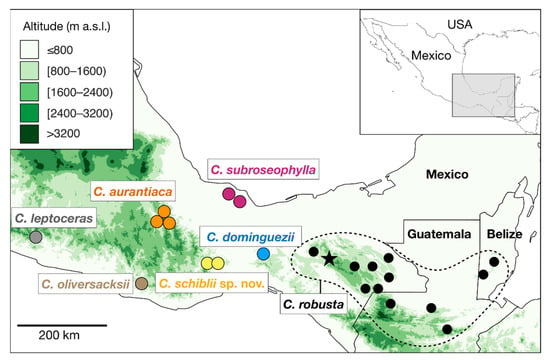
Figure 1.
Distribution map of the known populations of the seven species in the Ceratozamia robusta species complex. The figure is updated from our previous studies [8,9]. The putative new species from eastern Oaxaca (C. schiblii sp. nov.) occurs near the center of the distribution range and is represented by yellow circles. Black circles surrounded by a dotted line indicate the occurrence of populations of C. robusta, the species with the widest distribution in the complex. The star symbol indicates the neotype locality of C. robusta (Parque Nacional Cañón del Sumidero, Chiapas, Mexico). The species C. aurantiaca, C. subroseophylla, C. dominguezii, C. oliversacksii, and C. leptoceras are also part of the species complex. Green color scale indicates the elevation in meters above sea level (m a.s.l.).
In the course of evaluating various populations of the Ceratozamia robusta complex, we found that the populations from the eastern highlands of Oaxaca, Mexico, in the municipalities of Santiago Lachiguiri and Santa María Guienagati, have several morphological characteristics that distinguish them from other members in the species complex. By analyzing qualitative and quantitative trait variations of these populations compared to the other species within the complex, we have determined that these populations are distinct enough to represent a new species, which we here describe and illustrate as C. schiblii sp. nov.
2. Material and Methods
A total of 87 adult plants representing four populations from Chiapas, Oaxaca, and Veracruz belonging to all species (except C. leptoceras) in the C. robusta complex were analyzed in this study. We were unable to include C. leptoceras due to fieldwork limitations, but we consider the qualitative traits of this species according to its original description [10]. The geographic distribution of the species was mapped using QGIS [12] and the elevation raster layers of 30 s resolution of the NASA Shuttle Radar Topographic Mission (SRTM) 90 m Digital Elevation Database v4.1 deposited in DIVA-GIS.org [13]. We utilized morphometric data collected in previous studies [8,9] for the species C. aurantiaca, C. robusta, C. subroseophylla, and C. dominguezii, and herein we have added data for nine individuals of C. oliversacksii, as well as for 16 individuals of the putative new species, C. schiblii (Table 1, Figure 1).

Table 1.
Species compared in this study. Name of sampling locality, elevation in m above sea level (a.s.l.), and number of samples analyzed (n) in morphometric analyses are provided.
Following a similar methodology used in our previous studies [8,9], we observed the qualitative trait variation among the examined species (Table 2) and compared the measurements of seven leaf and leaflet traits commonly used as diagnostic characters in Ceratozamia [6,8,9,10,11] (Table 3). For the quantitative data, we performed the following tests implemented in PAST v.3.4 [14] to determine whether the morphometric variation can be used to distinguish the various species. First, Welch’s ANOVA was used to test whether the means of the trait variation across species were significantly different (Table 3). Moreover, for each trait, Tukey’s Q of pairwise differentiation between the putative new species C. schiblii sp. nov. and the other five species was calculated to distinguish the traits that significantly differ with respect to the others. By combining all the trait data, a linear discriminant analysis (LDA) was conducted to test whether the overall variation among species can distinguish the six species considered a priori. Finally, the pairwise Mahalanobis distances were calculated to test whether the six species are significantly separated, which would indicate that the overall morphological differentiation is well sorted among the examined species. Herbaria specimens collected from the examined populations were deposited in HEM, XAL, and MEXU (acronyms according to [15]).

Table 2.
Comparison of morphological variation among species of the Ceratozamia robusta species complex.

Table 3.
Morphometric differentiation of seven traits among the six Ceratozamia species examined. Overall differentiation estimated as Welch’s F in ANOVA and p-values is indicated. Number of samples (adult individuals) per population used in the analyses is indicated in Table 1.
3. Results
Our analyses of qualitative (Table 2) and quantitative traits (Figure 2) show that the populations from the eastern highlands of Oaxaca, Mexico, are distinct from others within the Ceratozamia robusta species complex and merit recognition as a new species. The plants of this new species, which we herein name C. schiblii sp. nov., differ from the other species in the complex by having coriaceous leaflets, a feature only shared with C. aurantiaca (Table 2). However, the two species can be clearly distinguished by the color of their emerging leaves, which are orange-brown to orange in C. aurantiaca and brown in C. schiblii. The second qualitative feature that readily distinguishes the new species from its congeners is the extremely long peduncles that make the seed cones pendulous at maturity, whereas they remain erect in all the other species within the complex (Table 2).
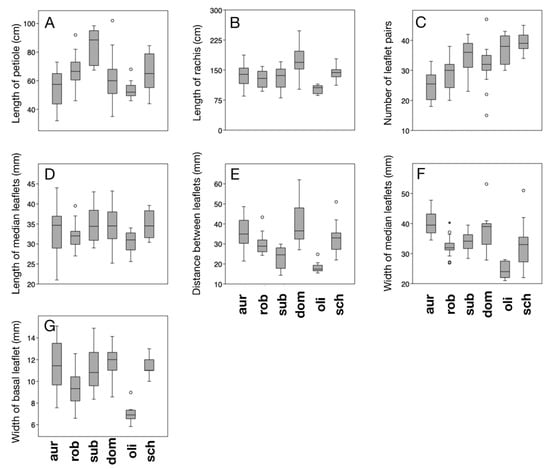
Figure 2.
Morphometric variation among the six species in the Ceratozamia robusta species complex analyzed in this study: Ceratozamia aurantiaca (aur), C. robusta (rob), C. subroseophylla (sub), C. dominguezii (dom), C. oliversacksii (oli), and C. schiblii (sch). The order of plots corresponds to the traits (A–G) listed in Table 3. Whiskers indicate standard error and circles indicate outliers.
The multiple statistical tests based on morphometric data supported the differentiation among species. All traits except the length of median leaflets showed significant overall differentiation among species (Table 3). In pairwise comparisons between C. schiblii and the other members of the complex (Table 4), it is notable that C. schiblii has petioles that are significantly longer than C. aurantiaca and C. oliversacksii and much shorter than C. subroseophylla (Figure 2A). The rachides in C. schiblii are significantly longer than in C. oliversacksii, but shorter than C. dominguezii, which is the species with the longest leaves and rachides [9] (Figure 2B). Most notable is that the number of leaflet pairs in C. schiblii is the highest among the species in the complex, but not significantly higher than in C. oliversacksii, which also has a high number of leaflet pairs (Figure 2C). The median leaflets were also found to be significantly longer than C. robusta and C. oliversacksii, but not different from the remaining species (Figure 2D). The distance between leaflets was similar to that observed in C. aurantiaca and C. robusta, but longer than in C. subroseophylla and C. oliversacksii, and shorter than C. dominguezii (Figure 2E). The width of the median leaflets of C. schiblii was among the narrowest in the complex (Figure 2F), with C. oliversacksii being the species with the narrowest leaflets. C. schiblii has wider basal leaflets than C. robusta and C. oliversacksii but does not differ significantly from the other species.

Table 4.
Pairwise morphological trait differentiation between the new species Ceratozamia schiblii and the other examined species in the C. robusta species complex. Values indicate F-values calculated in ANOVA. Abbreviations: sch = C. schiblii; aur = C. aurantiaca; rob = C. robusta; sub = C. subroseophylla; dom = C. dominguezii; oli = C. oliversacksii; ns = not significant; *: p < 0.05; **: p < 0.005; ***: p < 0.001.
The multivariate analyses were clearer at distinguishing the overall morphometric variation among species. The linear discriminant analysis (Figure 3) separated the convex-hulls of each species with little overlap among them. The two most important discriminant axes summarized the total variation as 59.1% and 23.3%, respectively. According to the loading scores represented as biplots in Figure 3, the traits with the highest contribution were the length of petioles (trait A), length of the rachides (trait B), and the number of leaflet pairs (trait C) (Figure 3), which is denoted by the longest biplots. The confusion matrix resulting from the LDA showed that most of the samples were correctly assigned to their species, with very few exceptions (Table 5). Likewise, the squared Mahalanobis distances among the six evaluated species were significantly high (Table 6), indicating that the overall morphometric variation is sufficient to distinguish the species in the C. robusta species complex.
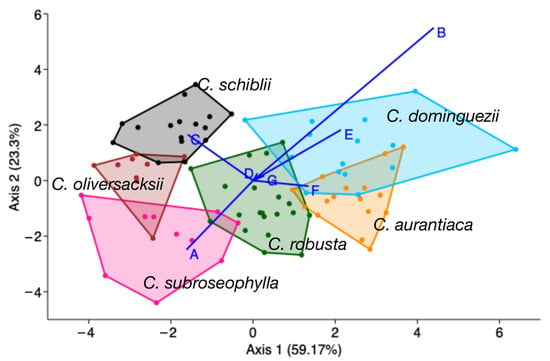
Figure 3.
Linear discriminant analysis plot showing the dispersion of the samples of six compared species along the two main axes. Biplots A–F indicate the direction and relative loading score of each trait variation along the two axes. Traits A–G correspond to those listed in Table 3: A, length of petiole; B, length of rachis; C, number of leaflet pairs; D, length of median leaflets; E, distance between median leaflets; F, width of median leaflets; G, width of basal leaflets.

Table 5.
Confusion matrix obtained from the Linear Discriminant Analysis (LDA). Rows indicate given groups, and columns indicate groups predicted by the LDA. Bold values indicate correctly assigned individuals to their own species, supporting their taxonomic identity. Abbreviations: aur = C. aurantiaca; rob = C. robusta; sub = C. subroseophylla; dom = C. dominguezii; oli = C. oliversacksii; sch = C. schiblii.

Table 6.
Squared Mahalanobis distances (below the diagonal) and p-values (above the diagonal) among the six examined species. All values are significant, suggesting complete morphological sorting among species. Abbreviations: aur = C. aurantiaca; rob = C. robusta; sub = C. subroseophylla; dom = C. dominguezii; oli = C. oliversacksii; sch = C. schiblii.
With the evidence presented, we propose the recognition of a new cycad species in the genus Ceratozamia that we name C. schiblii sp. nov.
New Species Description
Ceratozamia schiblii Pérez-Farr. & Gut.Ortega sp. Nov. (Figure 4, Figure 5, Figure 6, Figure 7 and Figure 8).
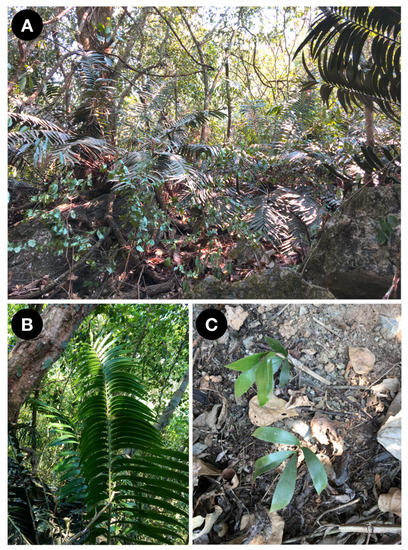
Figure 4.
Ceratozamia schiblii sp. nov. in habitat. (A) Adult plants. (B) Erect leaves and details of leaflets. (C) Seedlings.
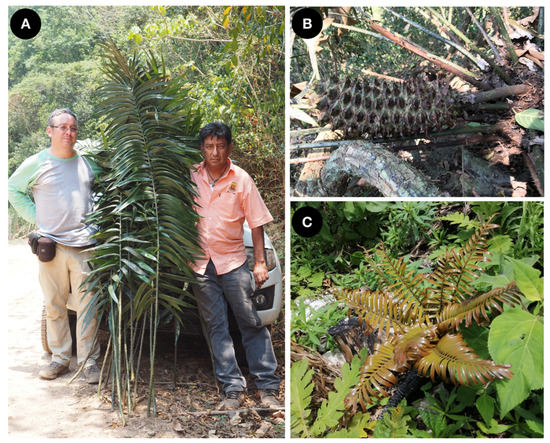
Figure 5.
Some of the distinctive features of Ceratozamia schiblii. (A) Leaves are one of the longest and with the highest number of leaflet pairs among the species of the C. robusta species complex (left: M.C.; right, M.A.P.-F.). (B) Megastrobili (seed cones) are pendulous and peduncles long. (C) Emerging leaves are of brown color. Photo A by Cesar Daniel Coutiño Ovando. Photos B and C by Miguel Angel Pérez Farrera.
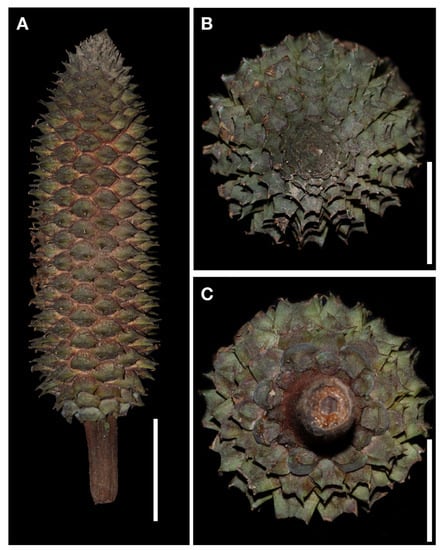
Figure 6.
Megastrobilus (seed cone) of Ceratozamia schiblii. (A) Lateral view (scale = 10 cm); (B) view from above (scale = 5 cm), (C) view from below (scale = 5 cm). Photos by José García González.
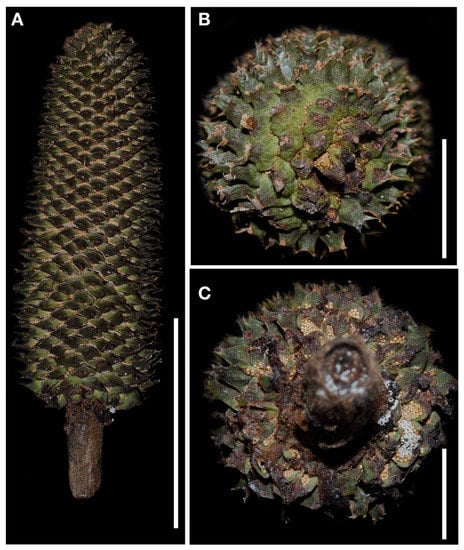
Figure 7.
Microstrobilus of Ceratozamia schiblii at near pollen dehiscence phase. (A) Lateral view (scale = 10 cm); (B) view from above (scale = 2 cm), (C) view from below (scale = 2 cm). Photos by José García González.
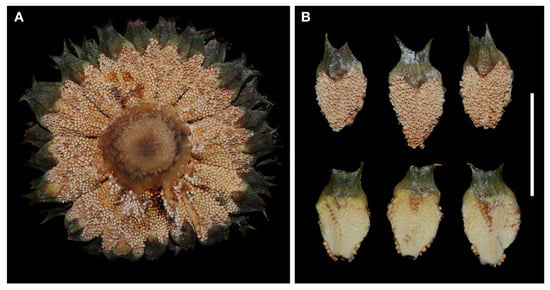
Figure 8.
Microsporophylls of Ceratozamia schiblii. (A) Transversal sectioned microstrobilus (pollen cone) with exposed microsporophylls. (B) Microsporophylls abaxial side (top) and adaxial side (bottom). Scale = 2 cm. Photos by José García González.
Holotype:—MEXICO. Oaxaca: Lachidola, 1290 m, 30 November 2021, Pérez-Farrera M. A., 4074 ♂ with Díaz Jiménez P., García González J., Pérez F. J. & Moreno Méndez G. (HEM). Isotypes: (XAL, MEXU).
Ceratozamia schiblii is distinguished from other species in the genus by its brown leaflets in emerging leaves, pendulous seed cone with a long peduncle, and the green color of mature pollen cones.
Plant rupicolous, unbranching. Stem cylindrical, erect, decumbent in older plants, covered with persistent leaf bases, 20–220 cm tall, 20–24 cm in diameter. Cataphylls persistent, brown and densely tomentose at emergence, triangular apex acuminate. Leaves pinnate 15–24 forming an open crown, erect, ascending, 161.2–262.5 cm long, 60.8–79.2 cm wide, brown at emergence, turning olive green at maturity. Petiole terete, 43.9–84.5 cm long, armed, dense with thick prickles. Rachis terete, 112–178 cm long, erect, with spaced prickles diminishing into apical part of rachis, green. Leaflets 34–45 pairs, coriaceous, opposite to subopposite in the medium part of the leaf, subopposite to alternate in the basal part, linear, subfalcate to falcate, margin entire, apex acute to acuminate, asymmetric; base broad attenuate, articulation green; veins 21–36, parallel, inconspicuous, not readily visible; median leaflets 30.4–39.6 cm long, 3–4.5 cm wide, 2.2–5.1 cm between leaflets, articulation 1–1.3 cm wide. Microstrobilus (pollen cone) solitary, conical, erect, olive green when mature, 22–33 cm long, 6.09–7.02 cm in diameter; peduncle densely tomentose, 4–8 cm long, 1.5–2.8 cm in diameter, brown. Microsporophyll cuneiform, distal face bicornate, 16–20 mm long, 10–14 mm wide, sporangia zone on abaxial surface 10–13 mm long, microsporangia grouped in sori of 3–4. Megastrobilus (seed cone) solitary, cylindrical, erect when emerging, descendent when mature, 25–28 cm long, 10.7–12 cm in diameter, brown at maturity; apex mucronate; peduncle tomentose, 20–21.5 cm long, 1.5–1.8 cm in diameter, brown. Megasporophylls peltate, bicornate, distal face 3.4–3.9 cm wide, 1.2–1.8 cm tall, pubescent, brown (including horns) at maturity, base light brown; peduncle tomentose, light-yellow to light-orange at maturity. Seed ovoid, sarcotesta cream when immature, orange-brown when mature, sclerotesta beige, with micropylar ridges 1.4–1.7 cm in diameter, 2.6–3.1 cm long.
Specimens examined: MEXICO. Oaxaca: Lachidola, 12 September 2021, Pérez-Farrera M. A. 4065 with García González J. & José Perez F. (HEM); 1260 m, 9 May 2019, Pérez-Farrera M.A. & Calonje M. 3764 ♀ (HEM); Santa María Guienagati, 9 March 2022, Pérez-Farrera M.A. with Díaz Jiménez P. & Villar Morales D. 4093 ♀ (HEM). 1200 m, 25 January 1996, Cerón C. M. 249 with Salas Morales S.M. & Morales H. (SERO, MEXU, XAL); Guevea de Humboldt, 1300 m, 30 March 1991, Campos V. A. & Torres C. R. 3614 (CAS; MEXU); La Chiviza, 1170 m, 24 Aug 1984, Torres R. & Martínez C. 5920 (CAS, MEXU).
Habitat description: Ceratozamia schiblii grows between 1100 and 1300 m a.s.l., in karstic tropical montane cloud forest and Quercus forest, according to the vegetation classification of Rzedowski [16]. The associated flora includes Pinus chiapensis (Martínez) Andresen, P. oocarpa Schiede ex Schltdl., Cupressus lusitanica Mill., Quercus laeta Liebm., Q. castanea Née, Clethra macrophylla M.Martens & Galeotti, Saurauia serrata DC., Podocarpus matudae Lundell, Chamaedorea pinnatifrons H. Wendl., Chamaedorea oblongata Mart., Chamaedorea tepejilote Liebm., Begonia nelumbonifolia Schltdl. & Cham., Anthurium cerrobaulense Matuda, A. scandens (Aubl.) Engl., Monstera deliciosa var. sierrana G.S. Bunting, Philodendron sagittifolium Liebm., Syngonium chiapense Matuda, Litsea glaucescens Kunth, Smilax purpusii Brandegee, Monnina xalapensis Kunth, Oreopanax xalapensis Kunth Decne. & Planch., Cleyera theaeoides (Sw.) Choisy, Styrax ramirezii Greenm., Ternstroemia tepezapote Schltdl. & Cham., Hedyosmum mexicanum C. Cordem., Palicourea elata (Sw.) Borhidi, Arachnothryx laniflora (Benth.) Planch., Cyathea divergens Kunze, Oreomunnea mexicana (Standl.) J.-F. Leroy, among others.
Etymology: The specific epithet was chosen to honor Leo Schibli (1958–2004), a founding member of Sociedad para el Estudio de los Recursos Bióticos de Oaxaca, Asociación Civil (SERBO, A.C.). His field explorations and specimen collections in Oaxaca resulted in the discovery of several new cycad species.
Key to the species of the Ceratozamia robusta complex: We provide a key to the species in the C. robusta species complex. Moreover, although C. mixeorum does not belong to the C. robusta species complex, we include it to make a distinction between it and the new species, given their geographic proximity. More traits that can distinguish the two species are discussed below.
| 1a. Plants with erect cone | |
| 2a: Plants with emerging orange leaves……………………………………………………………………………………………… | C. aurantiaca |
| 2b: Plants with green, reddish, yellowish, brown, or caramel emerging leaves | |
| 3a: Plants with visible veins on leaflets | |
| 4a: Plants with emerging yellowish-brown leaves……………………………………………………………………… | C. subroseophylla |
| 4b: Plants with emerging green leaves | |
| 5a: Leaflets membranaceous………………………………………………………………………………………… | C. leptoceras |
| 5b: Leaflets papyraceous……………………………………………………………………………………………………… | C. oliversacksii |
| 3b: Plants with inconspicuous veins on leaflets | |
| 6a: Plants with emerging reddish-brown leaves……………………………………………………………………………………… | C. robusta |
| 6b: Plants with newly emerging caramel colored leaves………………………………………………………………………………… | C. dominguezii |
| 1b. Plants with pendent cone | |
| 7a: Plants with emerging leaves of pea green color……………………………………………………………………………………… | C. mixeorum |
| 7b: Plants with emerging leaves of brown color…………………………………………………………………………………………… | C. schiblii |
4. Discussion
Before this study, we examined all the Ceratozamia specimens deposited in the herbaria MEXU, HEM, and XAL, and each was attributable to one of the already known Ceratozamia species; the only exceptions were the plants from the municipalities of Lachidola and Santiago Lachiguiri, in the eastern highlands of Oaxaca, Mexico. The plants from these sites were long recognized as C. robusta given their large trunks, leaves, and cones. With this study, we now show that those populations represent a new species, C. schiblii. Ceratozamia schiblii stands out for the length of the seed cone peduncle, which is extremely long (more than 20 cm). The seed cones emerge around May, are erect, and become pendulous with maturity as the weight increases. The species is also characterized by the pollen cone, which is green at maturity, unlike most other species within the C. robusta complex, which are typically yellowish or brown.
The LDA analysis shows a separation between the populations within the C. robusta complex on the Pacific and Gulf slopes. In general, the species of the Gulf slope are much more robust (leaves, rachis, and petiole) than those of the Pacific slope. Similar to the other species within the complex, C. schiblii populations are found on a mountain range identified as a refugium for tropical plants during the Neogene climatic fluctuations [17]. This pattern of the geographic distribution of closely related species in the complex supports the idea that mountains in southeastern Mexico have played an important role in the divergence and allopatric speciation in cycads [18].
Ceratozamia schiblii occurs in the southernmost spurs of Sierra Norte, Oaxaca, very close to Sierra Mixe, which is a region that is home to C. mixeorum Chemnick, T.J.Greg. & Salas-Mor. It is possible to confuse C. schiblii with C. mixeorum because both have seed cones with extremely long peduncles, a characteristic that is atypical in the genus [19]. However, whereas C. schiblii is part of the C. robusta species complex, C. mixeorum is part of a different clade in the phylogeny of the genus [20], being sister to C. matudae Lundell. The morphological characteristics that define the C. robusta species complex are the single, tall (maximum around 2 m), and thick (maximum around 40 cm in diameter) trunks, as observed in adult C. robusta plants, long leaves (usually longer than 2 m), long median leaflets (usually 30 to 40 cm [Figure 2D]), wide median leaflets (usually 3 to 4 cm [Figure 2E]), and a low number of leaflet pairs (from 15, as in C. dominguezii, to 47 as in C. oliversacksii [Figure 2C]). Ceratozamia mixeorum, as currently circumscribed [19], does not belong to the C. robusta species complex because it has bifurcated (or multi-furcated) trunks that are much shorter (up to 125 cm) and thinner (up to around 20 cm); leaves are shorter (the longest being less than 2 m), leaflets are narrower (2 to 3 cm), and the number of leaflet pairs is much higher (from around 50 to 77). However, C. mixeorum has some traits in common with the species in the C. robusta complex such as a similar length of median leaflets, or the large size of seed and pollen cones, which may contribute to their confusion. We suggest considering multiple traits when making any diagnosis. In the field, C. schiblii can be distinguished as having brown emerging leaves (bright pea-green in C. mixeorum), linear or subfalcate-to-falcate leaflets (linear-lanceolate or falcate in C. mixeorum), and wider median leaflets of 3–4.5 cm (2.1–2.9 cm in C. mixeorum). Furthermore, leaves can be longer in C. schiblii (161–262 cm) than in C. mixeorum (146–198 cm). In addition, C. schiblii adults are unbranched whereas C. mixeorum adults sometimes present two or a few branches of nearly equal length, and multiple crowns of leaves. Finally, it is interesting to mention that C. schiblii grows at lower elevations, at around 1170 to 1300 m a.s.l., but C. mixeorum occurs in cloud forests at high elevations, from 1440 to 1900 m a.s.l. [19], similarly to its closely related species C. matudae.
Based on the presented evidence, we conclude that the total number of species belonging to the C. robusta species complex is seven. However, the possibility of the discovery of novel wild populations remains open, which may result in an increase in the species of the complex. Further studies to test the distinction of more new species might also be facilitated with the inclusion of anatomical variation analyses, as they have been useful in the case of the C. miqueliana species complex [21]. Moreover, further phylogeographic studies in the complex and at the genus level may contribute to the resolution of the relationships among the species, which is an ongoing task that remains unresolved due to incongruencies presented in previous studies [20,22].
Author Contributions
Conceptualization, M.A.P.-F. and J.S.G.-O.; methodology, M.A.P.-F., J.S.G.-O., T.J.G., J.C., S.S.-M., M.C., and P.D.-J.; software, M.A.P.-F. and J.S.G.-O.; validation, M.A.P.-F. and J.S.G.-O.; formal analysis, J.S.G.-O.; investigation, M.A.P.-F., J.S.G.-O., T.J.G., J.C., S.S.-M., M.C., and P.D.-J.; resources, M.A.P.-F., T.J.G., and J.C.; data curation, M.A.P.-F. and J.S.G.-O.; writing—original draft preparation, M.A.P.-F. and, J.S.G.-O.; writing—review and editing, M.A.P.-F., J.S.G.-O., T.J.G., J.C., S.S.-M., M.C., and P.D.-J.; visualization, J.S.G.-O.; supervision, M.A.P.-F.; project administration, M.A.P.-F.; funding acquisition, M.A.P.-F. All authors have read and agreed to the published version of the manuscript.
Funding
This research received no external funding.
Institutional Review Board Statement
Not applicable.
Informed Consent Statement
Not applicable.
Data Availability Statement
Not applicable.
Acknowledgments
Thanks to four anonymous reviewers who helped us to improve the quality of our manuscript. The authors thank Cesar Daniel Coutiño Ovando, Alexis Fabian José Pérez, Gaspar Moreno Mendez, and Diego Villar-Morales for their support during fieldwork, and José García González for providing photos. Funding for this research was provided by the Montgomery Botanical Center through the Plant Exploration Fund. Field specimens examined were collected under permit No. SGPA/DGVS/08744 from SEMARNAT, Mexico.
Conflicts of Interest
The authors declare no conflict of interest.
References
- Whitelock, L.M. The Cycads; Timber Press: Portland, OR, USA, 2002; p. 532. [Google Scholar]
- Vovides, A.P.; Pérez-Farrera, M.A.; González, D.; Avendaño, S. Relationships and Phytogeography in Ceratozamia (Zamiaceae). In Cycad Classification: Concepts and Recommendations; Walters, T., Osborne, R., Eds.; CABI Publishing: Wallingford, UK, 2004; pp. 109–125. [Google Scholar]
- Pérez-Farrera, M.A.; Vovides, A.P.; López-Mendoza, S.; Hernández-Sandoval, L.; Martínez, M. Estimation of genetic variation in closely related cycad species in Ceratozamia (Zamiaceae, Cycadales) using RAPDs markers. Rev. Biol. Trop. 2017, 65, 305–319. [Google Scholar] [CrossRef] [PubMed]
- Mankga, L.T.; Yessoufou, K. Factors driving the global decline of cycad diversity. AoB Plants 2017, 9, plx022. [Google Scholar] [CrossRef] [PubMed]
- Calonje, M.; Stevenson, D.W.; Osborne, R. The World List of Cycads, Online Edition. 2022. Available online: http://www.cycadlist.org (accessed on 20 April 2022).
- Gutiérrez-Ortega, J.S.; Pérez-Farrera, M.A.; Vovides, A.P.; Chávez-Cortázar, A.; López, S.; Santos-Hernández, N.G.; Ruíz-Roblero, S.K. Ceratozamia sanchezae (Zamiaceae): A new cycad species from Chiapas Highlands (Mexico). Phytotaxa 2021, 500, 201–216. [Google Scholar] [CrossRef]
- Pérez-Farrera, M.A.; Vovides, A.P.; Hernández-Sandoval, L.; González, D.; Martínez, M. A morphometric analysis of the Ceratozamia norstogii Stevenson complex (Zamiaceae). In Cycad Classification: Concepts and Recommendations; Walters, T., Osborne, R., Eds.; CABI Publishing: Wallingford, UK, 2004; pp. 127–136. [Google Scholar]
- Pérez-Farrera, M.A.; Gutiérrez-Ortega, J.S.; Haynes, J.L.; Chemnick, J.; Salas-Morales, S.H.; Calonje, M.; Vovides, A.P. Ceratozamia aurantiaca (Zamiaceae): A new cycad species from the northern rainforests of Oaxaca, Mexico. Taxonomy 2021, 1, 243–255. [Google Scholar] [CrossRef]
- Pérez-Farrera, M.A.; Gutiérrez-Ortega, J.S.; Vovides, A.P.; Calonje, M.; Díaz-Jiménez, P. Ceratozamia dominguezii (Zamiaceae): A new cycad species from southeastern Mexico. Taxonomy 2021, 1, 345–359. [Google Scholar] [CrossRef]
- Martínez-Domínguez, L.; Nicolalde-Morejón, F.; Lorea-Hernández, F.G.; Vergara-Silva, F.; Stevenson, D.W. A novelty in Ceratozamia (Zamiaceae, Cycadales) from the Sierra Madre del Sur, Mexico: Biogeographic and morphological patterns, DNA barcoding and phenology. PhytoKeys 2020, 156, 1–25. [Google Scholar] [CrossRef] [PubMed]
- Martínez-Domínguez, L.; Nicolalde-Morejón, F.; Vergara-Silva, F.; Stevenson, D.W. Ceratozamia oliversacksii (Zamiaceae), a new species of gymnosperm from western Oaxaca, Mexico. Kew Bull. 2022, 77, 211–219. [Google Scholar] [CrossRef]
- QGIS Geographic Information System. QGIS Association. Available online: http://www.qgis.org (accessed on 20 April 2022).
- Hijmans, R.J.; Guarino, L.; Mathur, P. Diva-Gis Version 7.5 Manual. University of California. Available online: https://www.diva-gis.org (accessed on 21 April 2022).
- Hammer, Ø.; Harper, D.A.; Ryan, P.D. PAST: Paleontological statistics software package for education and data analysis. Palaeontol. Electron. 2001, 4, 9. [Google Scholar]
- Thiers, B. Index Herbariorum: A Global Directory of Public Herbaria and Associated Staff. New York Botanical Garden’s Virtual Herbarium. 2020. Available online: http://sweetgum.nybg.org/science/ih/ (accessed on 3 June 2022).
- Rzedowski, J. Vegetación de México, 1ra. Edición Digital; Comisión Nacional Para el Conocimiento y Uso de la Biodiversidad: Mexico City, Mexico, 2006; p. 504. [Google Scholar]
- Wendt, T. Las selvas de Uxpanapa, Veracruz-Oaxaca, México: Evidencia de refugios florísticos cenozoicos. An. Inst. Biol. UNAM Ser. Bot. 1989, 58, 29–54. [Google Scholar]
- Gutiérrez-Ortega, J.S.; Salinas-Rodríguez, M.M.; Ito, T.; Pérez-Farrera, M.A.; Vovides, A.P.; Martínez, J.F.; Molina-Freaner, F.; Hernández-López, A.; Kawaguchi, L.; Nagano, A.J.; et al. Niche conservatism promotes speciation in cycads: The case of Dioon merolae (Zamiaceae) in Mexico. New Phytol. 2020, 227, 1872–1884. [Google Scholar] [CrossRef] [PubMed]
- Chemnick, J.; Gregory, T.J.; Salas-Morales, S. Ceratozamia mixeorum (Zamiaceae), a new species from Oaxaca, Mexico with comments on distribution, habitat, and species relationships. Phytologia 1997, 83, 47–52. [Google Scholar]
- González, D.; Vovides, V.P. Low intralineage divergence in Ceratozamia (Zamiaceae) detected with nuclear ribosomal DNA ITS and chloroplast DNA trnL-F non-coding region. Syst. Bot. 2002, 27, 654–661. [Google Scholar]
- Vovides, A.P.; Pérez-Farrera, M.A.; Gutiérrez-Ortega, J.S.; Avendaño, S.; Medina-Villarreal, A.; González-Astorga, J.; Galicia, S. A revision of the Ceratozamia miqueliana (Zamiaceae) species complex based on analyses of leaflet anatomical characters. Flora 2020, 270, 151649. [Google Scholar] [CrossRef]
- Medina-Villarreal, A.; González-Astorga, J.; de Los Monteros, A.E. Evolution of Ceratozamia cycads: A proximate-ultimate approach. Mol. Phylogenet. Evol. 2019, 139, 106530. [Google Scholar] [CrossRef] [PubMed]
Publisher’s Note: MDPI stays neutral with regard to jurisdictional claims in published maps and institutional affiliations. |
© 2022 by the authors. Licensee MDPI, Basel, Switzerland. This article is an open access article distributed under the terms and conditions of the Creative Commons Attribution (CC BY) license (https://creativecommons.org/licenses/by/4.0/).